|
"Revealed: Tips To Buy
Jadeite ..."
The
Points To Remember When buying from Online Stores and Local Retail
Shops!
In this article, We will
discuss the following:
- What
is
Jadeite? Different types of Jadeite you can find in the market.
- What is Jade
(Nephrite)?
- What
are
the Jadeite look alike you can find in the market?
- How do you
grade
Jadeite?
- Tips
to
buy Jadeite
- And much
much more!
Important information about Jadeite and Nephrite:
CHEMISTRY
Jadeite, NaAlSi2O6.
Nephrite, Ca2(Mg,Fe)5(Si4O11)2(OH)2
CRYSTALLOGRAPHY Monoclinic,
though
usually microscopic
REFRACTIVE INDEX Jadeite 1.64 -
1.667.
Nephrite, 1.600 - 1.641
HARDNESS Jadeite 6.5 - 7.
Nephrite, 6 -
6.5
SPECIFIC GRAVITY Jadeite 3.25 -
3.36.
Nephrite, 2.90 - 3.02
CLEAVAGE None
HEAT SENSITIVE No
WEARABILITY* Excellent
SPECIAL CARE INSTRUCTIONS None
ENHANCEMENTS Dying, occasional.
Wax
impregnation, occasional. |
What
is Jadeite (翡翠)(硬玉)?
Jadeite is:(found in the internet)
- A pyroxene mineral consisting of silicate of
sodium
and aluminum, occurring in the form of light green monoclinic crystals.
It is the tougher and more highly prized variety of jade.(Jadeite and
nephrite are known to the Chinese as Jade).
- A hard, translucent variety of jade which is
rarer
than the other varieties of nephrite and comes
in a variety of colors such as orange, pink, yellow, brown, blue,
violet, and black.
Jadeite
Color
Although famous for its green, pure jade is actually white, with
impurities forming green, red, yellow, pink, white, violet, orange,
blue-green and brown. Jadeite is usually more vivid in color than
Nephrite. Jadeite is the only one of the two that produces the highly
prized emerald green Jade called Imperial Jade. Jadeite gets this
emerald color from chromium. Other colors are also formed from
impurities. Brown indicates the presence of iron and Violet, manganese.
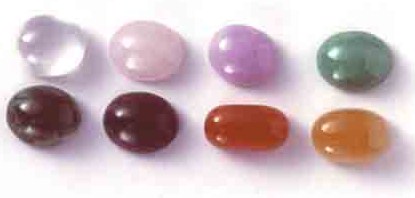
Jadeite is found in Burma, California, Guatemala, Russia, and Japan.
Only the Jadeite found in Burma is of the gemstone grade; They are cut
and
carved in many of the Asian countries like Burma, Thailand, and China
and then sold. Jadeite from Burma was not introduced into the Chinese
market before the late 1800's. Replacement of nephrite by Burmese
Jadeite came quickly as the preferred stone, due to the unique colors
of the Burmese Jadeite (green, lavender, yellow and orange, and its
greater translucent quality). Today Jadeite from Burma suggests fine
quality Jadeite.
Different
colors
of jadeite
What
are the different types of Jadeite you can find in the market?
The Jadeite showing up on market presently can be classified into A
jade, B jade ,C jade and B+C jade.
A- jade indicates the natural jadeite without undergoing any artificial
treatment, alteration or enhancement. Such kind of natural
jadeite
does not change with the passage of time. It can be preserved forever
and wears well. (Only A jade will appreciate in value)
B- Jade is defined as the natural jadeite having undergone a process of
acid treatment, removed the impurities and impregnated with colloidal
silica or resin. Normally, this kind of jadeite will turn out
yellow
gradually in 3-5 years of time and then the surface color will come off
due to the ageing of resin or colloid. Meanwhile, the composition of
inherent texture of jadeite has been destroyed during the acid
treatment which affects immediately its durability.
C-Jade is specified as the natural jadeite having undergone artificial
treatment, plus adding the new pigment substance. We may also
say that not only its internal texture has been
undermined but also its internal color was artificially added in.
B+C Jade- Jade that has been impregnated with colloidal silica or resin
as well as dye with pigment susbstance.
  
Type B jadeite
|
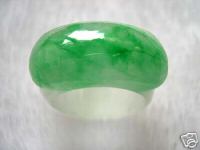 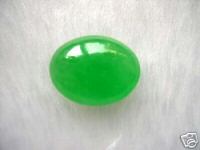 
Type C jadeite |
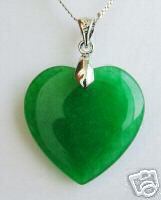  
Type B + C jadeite |
What
is Nephrite (軟玉)?
Chemistry: Ca2(Mg,Fe)5(OH)2(Si4O11)2
, a
variety
of actinolite.
Index Of Refraction:
1.62 (nephrite)
Hardness: 6.5 - 7
Cleavage: n/a-massive
stone
Crystal System:
monoclinic
Nephrite Color
Pure Nephrite is white. Nephrite
is usually green or creamy white, but can also be beige, yellow, blue
or black and often contains veins of color. The presence of iron
provides the green in nephrite. |
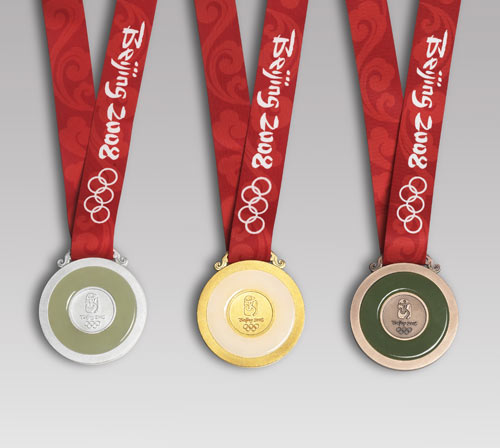
Jade has been used by the Chinese for many thousand years.A jade
culture was subsequently developed and made great progress in the
Chinese history. Amongst others, jade is closely related to
Chinese idoms , Chinese characters, Chinese poems,
Chinese
religion, daily utensils, relics unearthed from the ancient tombs, the
imperial seals of differnt dynasties ... just to name a few.
Even the medals to be used in Beijing 2008 will be made of
jade.
Nephrite image
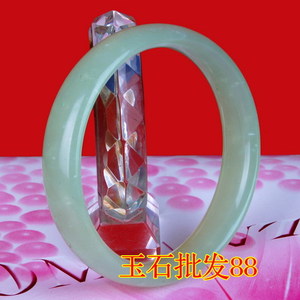 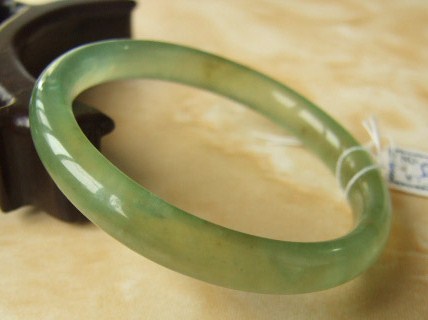
You just have to remember that jade (nephrite) is softer than jadeite,
the luster is weaker; and the price is very much cheaper than that of
jadeite. A good quality jadeite bangle may cost you US$10,000
while a good quality nephrite may cost only US$500. That is
why as
a tourist in the Far East (namely, China, Hong Kong Taiwan, Singapore
etc), you may be conned to pay for the price of jadeite when you are
given a nephrite. Selling price of jadeite in such
stores as
a***,e*** and y*** are really cheap! You are your own judge, whether
they are able to supply you with good quality jadeite at that price.
Most of
the time, they are selling you jadeite look-alikes. Good quality
jadeite can never be cheap!!! They are in short supply and price
appreciates yearly.)
What
are the Jadedite look alike you can find in the market?
| NAME |
COLOR |
HARDNESS |
SG |
RI |
REMARKS |
| Nephrite |
white, dark green |
6 |
2.9-3.1 |
1.62 |
black spot |
| |
blackish green |
|
|
|
greasy luster |
| |
color even |
|
|
|
|
| |
|
|
|
|
|
| Serpentite Jade |
yellowish green, white |
4.5 |
2.58-2.62 |
1.52 |
waxy luster |
| |
apple green, black |
|
|
|
|
| |
color even |
|
|
|
|
| |
|
|
|
|
|
| Hydro-grossular |
Green, yellowish green |
6.5 |
3.48 |
1.73 |
uneven composite |
| |
|
|
|
|
|
| Aventurine Quartz |
grassy green |
6 ~ 7 |
2.66 |
1.55 |
vitreous luster |
| |
|
|
|
|
parallel |
| |
|
|
|
|
|
| Chalcedony |
fresh green, color even |
7 |
2.6 |
1.54 |
vitreous luster |
| |
|
|
|
|
very fine structure |
| |
|
|
|
|
|
| Agalmatolite |
light green, yellowish
green |
2.5 |
2.8 |
|
waxy luster |
| |
|
|
|
|
|
| Saussurite |
white, dark green,
light green |
7.5 |
2.7-3.2 |
1.56-1.7 |
unstable |
| |
unven |
|
|
|
|
| Amazonite stone |
greenish blue or bluish
green |
6 |
2.56 |
1.53 |
not transparent |
| |
|
|
|
|
|
| Chrysoprase |
apple green even |
7 |
2.66 |
1.54 |
color evenly spread |
| |
|
|
|
|
|
| Dyed Quarzite |
fresh green even |
7 |
2.65 |
1.55 |
can detect the dye |
| |
|
|
|
|
|
| Green glass |
fresh green very even |
5.5 |
2.49-2.7 |
1.52 |
bubble |
| |
|
|
|
|
|
| Albite |
white, transparent |
6 |
2.64 |
1.53 - 1.59 |
looks like ice jadeite |
Chrysoprase
Glass
Emerald
Nephrite
Chalcedony
How do you grade Jadeite?
Right now
there
is no common system to grade Jadeite in the market - like the
4C system used to grade the diamond. However 4C2T1V model is widely
in China and Hong Kong.
- Color
- Craftsmanship
- Clarity
- Crack
- Tranparency
- Texture
- Volume
Grading process
Step one: Grade
the color in terms of Tone, Hue, Saturation (same as diamond) and
Evenness. It is best to view the color under the sunlight. Price will
decrease if the jadeite it too blue or too yellow. It will also worth
less if the color is very uneven.
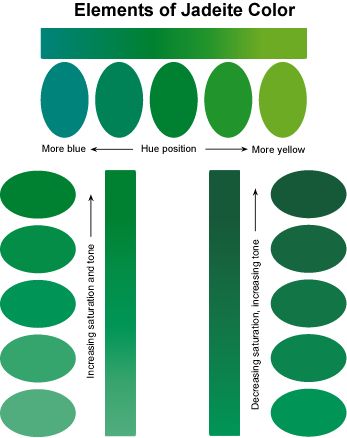
Step two: Grade the
transparency and texture
Jadeite transparency
is characterized with one of the
following terms:
- Transparent
- semitransparent
- Translucent
- semitransluscent
- Opaque

Transparent jadeite is more valuable than opaque jadeite. And
the price
can differ many hundred times.The left one is considered
opaque as
you can't see the lines below. The one in the middle is
considered translucent, as you can see the lines below vaguely. And the
right one is considered tranparent as you can see the two lines below
vividly; hence it is highly valued.
Texture
Texture refers to the internal characteristics of the jadeite
under magnification. Jadeite is formed by a cluster of microsopic
crystals. The chemical bonding and the atomic structure
within
the jadeite will affect its luster and transparency. The
smaller
the size of the crystals the more valuable the jadeite is.
Step
three: Grade
the Craftsmanship in terms of Shape, Cut, proportion, thickness,
symmetry, and the
standard of polishing.
This is very similar to grade the
cut of
diamond.
Step
four: Grade
the volume
of the completed piece and adjust the valuation.
The
valuation is
based on
the type of finished products, and the wastage for that product. The
higher the wastage; the more expensive is the finished product.
And without carving will be more valuable than the one with
carving. (They carve away the problem spots or cracks in the jadeite.)
Everything being equal, bangle will be more expensive than pendant,
cabochon and display items (valuation is in that order).
Step five: Grade
the
crack and clarity to minus the value.
Depending
on the size of the
crack whether can be spotted by the naked eyes.
| Grade |
No |
Minor |
Difficult |
Detectable |
Easily |
Obvious |
|
Crack |
Crack |
to see crack |
Crack |
detectable Crack |
Crack |
| Value |
100% |
-5% |
-10% |
-20% |
-40% |
-60% |
Clarity
Clarity
refers to
the types of inclusions found in the jadeite. Presence of
different types of Mineral will make certain part of the
jadeite black, brown or white. And the color can be in the
form of
spots, silk-like, or vein-like. The shape, size and location
of
the inclusions will affect the valuation of the jadeite, more so for
high quality jadeite.
Now that
you
have some ideas on how jadeite is valued in the market, let me tell you
the tips to buy jadeite.
Tips
to
buy Jadeite:
Step one: To determine whether it is a jadeite.
Step two: Whether the jadeite has undergone any enhancement
treatment.
To determine
whether
it is a jadeite, you may do the following:
- Observation the luster and
color
of the gemstone with naked eyes.
- Observation it with a 10X loupe
- Carry out test with your tools
Step
one : check the luster and color
Ms Barbara Smigel clearly shows in
her free geomology course that gemstone
luster is characterized with one of the
following terms:
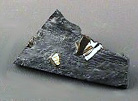 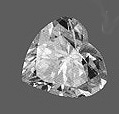  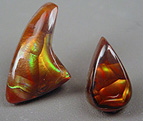 [Pyrite (in shist): metallic;
diamond: adamantine (like diamond); zircon: subadamantine; fire agate:
vitreous (like glass)]
[Pyrite (in shist): metallic;
diamond: adamantine (like diamond); zircon: subadamantine; fire agate:
vitreous (like glass)]
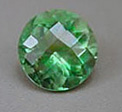  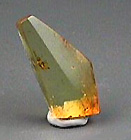 [Fluorite: subvitreous;
nephrite jade: greasy; amber: resinous]
[Fluorite: subvitreous;
nephrite jade: greasy; amber: resinous]
 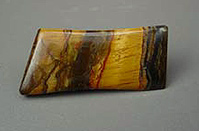 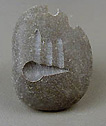 [Pearl: pearly; tiger'seye:
silky; granite: dull]
Only Jadeite
has vitreous luster; Nephrite is greasy;
and most of the look-alikes are either greasy or waxy.
[Pearl: pearly; tiger'seye:
silky; granite: dull]
Only Jadeite
has vitreous luster; Nephrite is greasy;
and most of the look-alikes are either greasy or waxy.
Color
In general, more than one color can be found in a piece of jadeite.
The green is never evenly displayed in the jadeite.
On a
piece of white jadeite, the green color may be in a form of dots,
veins-like, strips and spots with different tones and intensity. If the
greenness is unnatural, if may be dyed.
Step Two:
Use
the loupe
The table below shows how you can use naked eyes and 10X loupe to
distinguish between Typa A and B jadeite.
|
A
type |
B
type |
| Colour |
Natural |
with yellow tone |
|
|
the green is relatively fresh |
|
|
unnatural |
|
|
|
| Luster |
Transparency |
More transparent |
|
consistent |
than before treatment
Top : Using spectroscope to determine Type C jadeite (Dyed )
Below: Using spectroscope to determine Type B + C jadeite
|
|
with the type |
|
|
of Jadeite |
|
|
|
|
| Surface |
pit hole |
pit hole |
| features |
little or none |
little to a lot |
|
|
|
|
Crack |
May appear especially aged |
|
never appeared |
type B jadeite |
|
|
|
| Structure |
Natural structure |
loose structure; with uncleared borders |
|
|
and directions |
|
|
|
| SG |
3.40 to 3.30 |
lower than type A |
|
|
|
| UV
lights |
None or orangy red |
will show blue and white light. |
|
if it is oily |
not applicable to deep coloured |
|
|
jadeite |
Using a 10 X loupe, you should be able to see the
following from the surface of the different types of Jadeite.
Orange
peel surface of Type A jadeite.
Root of color Type A,
Type
B and
Type B + C
Step
three: use
your tools
Hardness Test
Gem's
hardness means its resistance to scratching and wearability. We always
use Moh's to show it's hardness. The table below shows its
class:
|
Moh's
|
1
|
2
|
3
|
4
|
5
|
6
|
7
|
8
|
9
|
10
|
|
The normal mineral
|
Steatite
|
Plaster
|
Calcite
|
Fluorite
|
Apatite
|
Feldspar
|
Quartz
|
Topaz
|
Corundum
|
Diamond
|
|
..The
hardness of common gems:
|
Gems name
|
Diamond
|
Synthetic ruby, sapphire
|
Cubic zirconia
|
Synthetic spinel
|
Topaz
|
Crystal
|
Glass
|
|
Hardness
|
10
|
9
|
8.5
|
8
|
8
|
7
|
5.5
|
|
..The
hardness of common comparative object:
|
Hardness
|
2.5
|
3
|
5.5
|
6~7
|
9.5
|
|
Common comparative
object
|
Nail
|
Copper coin
|
Knife、
Glass
|
Steel file
|
Carborundum
|
|
Since the hardness of a knife (5.5) is lower than that of a
jadeite (6.5-7),when you use the knife to scratch the jadeite, no mark
will be left behind. On the other hand, you will find
scratching
mark on the glass if you use jadeite to scratch it.Since this is a
destructive test, you can always ask the seller to do the test for
you, since he claims to sell you the jadeite.
Spectroscope
Test
Using spectroscope to determine Type A, Type B and
B+C
jadeite.
Green type A jadeite will always exhibits an unusual
pattern in the red/orange portion of the spectrum. You will
see a
triplet -three bars with each bar stronger than the one adjacent to it.
The stongest bar will be at about 685; the next bar is weaker
and
appears at about 660; the third bar is the the weakest and appears at
about 630.
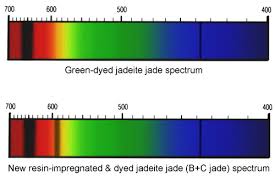
Top : Using spectroscope to determine Type C jadeite (Dyed )
Below: Using spectroscope to determine Type B + C jadeite
Specific
Gravity
Test, Reflective Index Test, and UV Test
The most effective way is
to measure the gemstone's specific gravity
(Jadeite: 3.25-3.36; Nephrite: 2.90-3.02) and its reflective index
(Jadeite: 1.64-1.67; Nephrite: 1.60-1.64) to confirm what you are
buying is Jadeite. Then use UV lamp and spectroscope to
determine
whether it has been treated. Unfortunately this can only be
carried
out in your lab. On the other hand,experienced buyers are able to use
their hands to gauge the specific gravity of the gemstone.
Armed 10X
loupes and
a tourch light, they are able to see whether the gemstone is jadeite;
and they are very good at it!
Final tip
to buy
jadeite
If
the jadeite you want to purchase is of a high value; it is always
worthwhile to pay for an independent report to confirm what you are
buying is genuine Type A jadeite. A sample report from a reputable
institute in Singapore is reproduced below for reference.
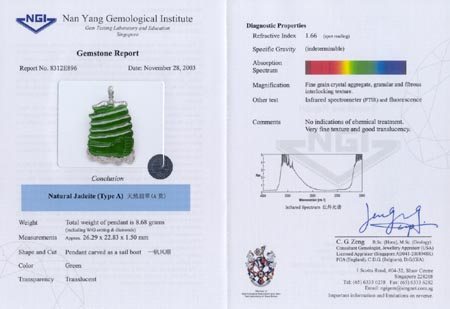
Hope that you have benefited from my tips to buy jadeite.
|